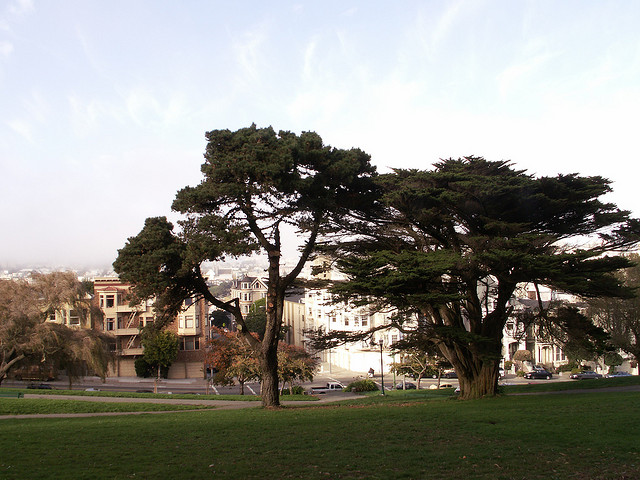In the shadow of the picture-perfect Painted Ladies, Alamo Square is often taken as little more than a hillside for gawkers.
Tourists usually come to the park to look outside of it. But San Francisco officials are hoping to change that perspective as they embark on one of the largest restoration projects ever planned for the park since its 1857 origins.
“We want to turn the tide and make sure the view into the park is as beautiful as the view out,” said Steve Cismowski, a San Francisco Recreation and Park Department neighborhood service area manager.
The aim is to restore Alamo Square’s vintage, Turn of the Century look, and to do so the city needs to replace a failing irrigation system with a new one. Ballpark cost: $2.3 million.
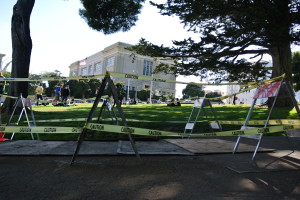
April Sinclair, a spokesperson with the San Francisco Public Utilities Commission, which is partnering with the parks department on the irrigation project, said the new system could save 3.26 million gallons of water a year — 37 percent of its water usage. Design work on the system is expected to commence this month.
The utilities commission, which manages San Francisco’s water, designated Alamo Square a “high water usage park” along with Balboa Park, Alta Plaza and Jefferson Square Park, which have all completed similar projects. A typical irrigation system should last at most 20 years, and Alamo’s hasn’t been touched for more than 40, Cismowski said.
Signs that something must be done are apparent. On one of the park’s network of paths, where wind-blown willows, palms and cypress trees tower above, a square of plywood and construction tape covers what park officials consider evidence of yet another underground break in the
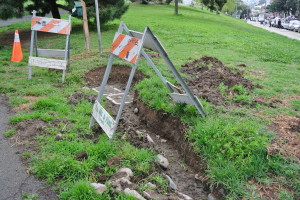
irrigation system’s main line. The public has been kept out of numerous leaky areas until they could be patched up, or otherwise repaired.
But one curious side note to the irrigation project is the park’s history. Apparently, the water bubbling up could be, in part, from underground natural springs which trickle throughout the park, said Joel Pomerantz, a natural history educator in San Francisco who studies city watersheds and leads walking tours for his brainchild Thinkwalks.
Pomerantz doesn’t have any maps chronicling the springs’ history, but he said early development of the park and its high water content points to the existence of springs.
Alamo Square was created on top of sand dunes in the 1850s, but the 260-foot-high hill that the park sits upon includes more than just sand, Pomerantz said. It also has serpentine rock, which is commonly found by springs.
“Here at the top of the hill, the springs are visible,” he said, pointing to trickles of water running into stone gutters and drains throughout the park. “The stone gutters and 29 drains make it clear that this park was designed for springs. They wouldn’t have been constructed if there wasn’t natural water present.”
The park was even named after a tree that requires much water – more than a mere sprinkler system can provide – to grow and thrive, Pomerantz said.

‘Alamo’ means ‘poplar tree’ in Spanish and in the early 1800s, the lone cottonwood on Alamo Hill marked a watering hole along the horseback trail from Mission Dolores to the Presidio, according to the Alamo Square Neighborhood Association website. Mayor James Van Ness set aside 12.7 acres around the hole in 1856, naming it Alamo Square. It was confirmed by the state legislature the following year as a public park.
Cismowski, of Recreation and Parks, agreed he’s heard of original springs in the area that might have been used as a watering hole for livestock before the spot was designated park land. But, he added, he’s never seen any hard evidence of springs actually being there.
“It seems odd that there would be springs coming out of the top of a hill,” he said. “It happens. But I’m more suspect that what is probably right is that there are underground leaks in the irrigation system that we are unaware of.”
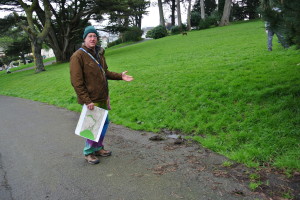
Although ancient springs aren’t on the city’s radar during this irrigation project, park officials are concerned with preserving the cultural history of the park as they complete their work.
The land is filled with an old growth of trees whose deep roots make underground renovations tricky.
“It would be one thing if we were starting completely fresh, with a completely new park landscape, it would be a lot easier to lay out the irrigation,” Cismowski said. “But any time we have a tree root concern, it’s imperative that you trench around it. We want to minimize the damage to the existing tree canopy and also provide for even coverage on the ground plain.”
Many of these trees are foreign varieties that were brought in during the Victorian era, when the ideal for garden landscaping was imported, exotic species. An attractive crop of palm trees from the Canary Islands can still be found within the park’s forest, along with Italian poplars and Australian eucalyptus.
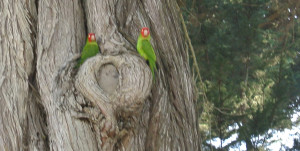
While there is habitat value from having a mature stand of trees, their exotic nature creates an artificial environment that can be difficult to sustain in San Francisco. However, park officials are determined to maintain the area by importing water, nutrients and other necessities to keep its vintage look intact.
Even the pathway layout of the park demonstrates a Turn of the Century design that the city does not want to disrupt during renovations.
“There’s an interest in keeping it feeling like a park that has been around for over 100 years, which it has,” Cismowski said. “It’s not like we can realign pathways significantly or change grades or modify the park in any significant way in that regard. After the irrigation project, it needs to look and feel like Alamo Square Park.”
Dhyana Levey is a contributor to Bay Nature.
- The postcard perfect view from Alamo Square. Photo: Blue/Flickr

